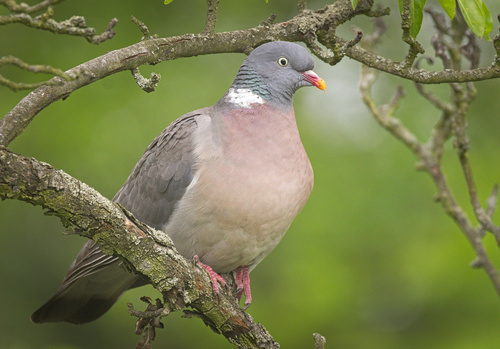
Common Wood Pigeon
The Common Wood Pigeon (Columba palumbus) is a large, widespread pigeon species found throughout Europe and parts of Asia and North Africa. It plays a significant role in seed dispersal within its varied habitats, from woodlands and forests to agricultural fields and urban parks. While not typically considered a bird of significant cultural importance, it is a familiar sight and sound in many regions, often recognized by its distinctive cooing call and the white patches on its neck and wings. It is an adaptable species, thriving in diverse environments.
38-44.5 cm
Length
68-80 cm
Wingspan
Least Concern
Conservation Status
Distribution
The Common Wood Pigeon is native to Europe, western Asia, and North Africa. Its range extends from the British Isles and Scandinavia eastward to western Siberia, and south to the Mediterranean region, including parts of Morocco, Algeria, and Tunisia. It has also been introduced to other areas, though not always successfully. Migratory patterns vary; northern and eastern populations tend to be migratory, while western and southern populations are often resident.
Lifespan
The average lifespan in the wild is 3-5 years, but individuals can live up to 16 years.
Common Wood Pigeon's Habitat
Habitat Types
Woodlands, Forests, Agricultural fields, Urban parks, Gardens, Hedgerows
Climate Zones
Temperate, Boreal, Mediterranean
Adaptations
The Common Wood Pigeon's adaptability to various habitats stems from its generalist diet and ability to nest in diverse locations. Its strong flight allows it to cover large distances in search of food and suitable nesting sites. It can tolerate human presence, allowing it to thrive in urban and suburban environments.
Variations
Several subspecies are recognized, differing slightly in plumage and size. For example, *Columba palumbus azorica* is found in the Azores, and *Columba palumbus casiotis* is found in parts of the Middle East.
Appearance
Breeding Plumage
Plumage is generally consistent year-round, with subtle differences.
Seasonal Feather Changes
Adults experience a partial post-breeding molt.
Sex Based Plumage Differences
Males and females have similar plumage, though males may have slightly more intense coloration on the breast.
Notable Features
White neck patches (adults), White wing bars visible in flight, Pinkish-grey breast, Grey head and back
Diet and Feeding
Primary Foods
Seeds, Grains, Berries, Green plant material, Invertebrates (occasionally)
Foraging Behavior
The Common Wood Pigeon primarily forages on the ground, pecking at seeds and other food items. It can also be seen feeding in trees and shrubs, particularly on berries and buds. They are known to form large flocks, especially during the non-breeding season, when foraging in agricultural fields.
Specializations
They have a crop, a specialized pouch in the esophagus, which allows them to store large quantities of food before digesting it. This is particularly useful for quickly gathering food in exposed areas.
Seasonal Diet Variations
Diet varies seasonally depending on food availability. In spring and summer, they may consume more green plant material and invertebrates. In autumn and winter, seeds and grains become more important, especially in agricultural areas.
Behavior
Social Structure
Common Wood Pigeons are often seen in pairs during the breeding season, but form large flocks during the non-breeding season, sometimes numbering in the thousands. These flocks can cause significant damage to agricultural crops.
Communication
A distinctive cooing call ('coo-COO-coo-coo-coo'), Wing clapping during display flights, Low-intensity throaty calls
Migration
Northern and eastern populations are migratory, moving south for the winter. Western and southern populations are generally resident or only undertake short-distance movements in response to food availability.
Territorial or Group Behaviors
During the breeding season, males defend territories around their nests. Outside of the breeding season, they are highly gregarious and form large flocks.
Conservation
Threats
Habitat loss (though adaptable), Agricultural intensification, Hunting (in some regions), Pesticide use (indirectly)
Protection Programs
General wildlife protection laws, Habitat conservation initiatives
Local National Laws
Protected under various national and international wildlife laws, but may be subject to regulated hunting in some areas.
Population Trend
Stable
Population Estimates
The global population is estimated to be in the tens of millions, and it is considered a common and widespread species.
Interesting Facts
They are strong fliers
They can reach speeds of up to 60 kilometers per hour.
They can drink without lifting their heads
Unlike most birds, they can suck up water continuously.
They produce 'crop milk'
A nutritious secretion from the crop lining, fed to young chicks.
Faqs about Common Wood Pigeon
What is the difference between a wood pigeon and a feral pigeon?
Wood pigeons are larger, have white neck patches and wing bars, and are generally found in more rural or wooded areas. Feral pigeons are descended from domesticated rock doves and are typically found in urban environments, lacking the distinctive white markings.
Are wood pigeons pests?
In some agricultural areas, large flocks of wood pigeons can cause damage to crops, leading to them being considered pests. However, they also play a role in seed dispersal.
What should I do if I find a baby wood pigeon?
If the chick is uninjured and appears healthy, it is best to leave it alone, as the parents are likely nearby. If it is injured or in immediate danger, contact a local wildlife rehabilitation center. *Consult a professional for expert advice.*
Copyright @ Nature Style Limited. All Rights Reserved.
 English
English